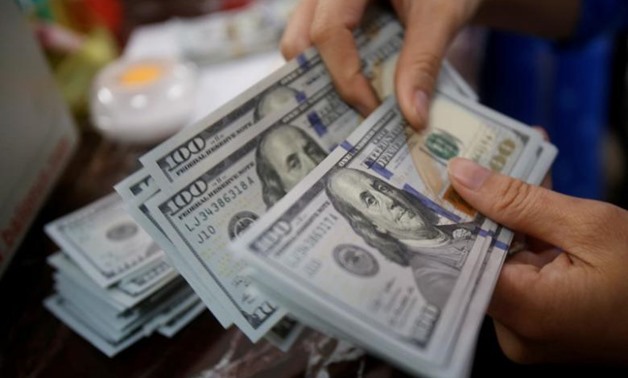Get our take on what to expect in the FX market this week, and why the pound could see further gains.
As we start a new week, some of you may still be wondering why markets reacted as they did to Friday’s payrolls report. The overall number of jobs created was much weaker than expected, with 199k jobs created, weaker than the 400k median analyst estimate. However, the unemployment rate fell to 3.9%, and crucially wage growth was also stronger than expected, rising 0.6% last month, pushing the annual rate to 4.7%, beating the 4.2% expected. The labour market in the US is strong, and wage growth is still moving higher. This makes a rate hike from the Federal Reserve in March more likely and Treasury yields surged. The question now is, will this continue, and why is the dollar not rising in tandem?
What’s next for the dollar?
The dollar surged early last week; however, the dollar index fell back from its recent high on Friday and fell below the key 96.0 level. Traders will be eyeing up whether the greenback can reclaim this level as we wait for the chair of the Federal Reserve, Jerome Powell, to appear at a Senate hearing on Tuesday. Even though the headline NFP figure was weaker than expected, as we mention above, the details of the latest US labour market report were strong. The labour market is tight in the US, and this supports an earlier rate rise from the Fed. At the end of last week, a number of investment banks were bringing forward their expectations of a rate rise from the Federal Reserve to March. We have mentioned in prior notes that the financial markets have already started to price this in. The CME Fedwatch tool is now pricing in a 69.5% chance of one 25 basis point rate rise from the Federal Reserve at its March meeting. Was the reluctance of the dollar to ride the Treasury yield wave higher due to fears of market exuberance and the small chance that the chair of the Federal Reserve will try to scale back the timing of the potential rate hike when he testifies on Tuesday? This might be part of the reason why the dollar was muted at the end of last week, but here are a couple of other reasons:
1, GBP is in focus:
The pound was the best performer vs. the USD at the end of last week. GBP/USD rose 0.44%, it is just below the key $1.3600 level, and has retraced 61.8%, a key Fibonacci level of resistance, of the end of October high to the 22nd December low. If GBP can break above this level at the start of the week, then there is plenty of room for more upside in our view. We think that the focus on US rate rises is also boosting the pound, as it reminds the market that the Bank of England was the first of the central banks to raise interest rates in December. If the BOE and the Fed tread a similar path, then a hawkish Fed this week could boost the pound if it suggests the BOE will follow suit.
2, Equities
US stocks had a rocky start to the year. The Nasdaq was down some 4.5% last week, while the Dow Jones fell a mere 0.3%. The contrasting fortunes between growth and value are clear to see: The Technology Select Sector SPDR Fund, which tracks a range of US tech stocks, was down some 4.6% for the week, while the Financial Select Sector SPDR Fund, which tracks banks and other financial firms in the US, was up 5.4% for the week. The theme of the first trading week of the new year was clear: banks are in, while tech is out. If this theme prevails, then this is also positive for some European indices versus their US counterparts, as European indices, particularly the FTSE 100, are more value focussed and are trading at lower multiples than US indices. Since the start of this year, European indices have outperformed their US counterparts, and this could also be limiting dollar upside for now.
Thus, the dollar could be hamstrung, even in the face of rising expectations for Fed rate increases and for now we think that the pound should outperform the greenback.
US inflation could be near the peak
Elsewhere, the focus this week will be on some key US inflation data. The US CPI rate for December is released on Wednesday and the market is expecting a 0.5% increase month over month, and a 7.1% annual rate of CPI, which would be the highest level since February 1981! Another 40-year high in consumer prices is likely to push up expectations of a fed rate hike in March closer to the 80-90% probability mark. However, inflation above 7% could signal that we are close to the peak in price growth, as demand eases and supply chain problems start to work their way out of the system. Thus, the market impact of this week’s CPI report could be fairly muted, as traders are already expecting a big number.
UK economy could return to pre-pandemic level
the other major data point this week is monthly UK GDP for November. This data is expected to show that the UK economy expanded by 0.5% between October and November last year, which would see the UK economy return to pre-pandemic levels for the first time since the pandemic struck. However, the risk to the UK economy is whether the rise of Omicron in December knocked the recovery off track. Early Christmas shopping and a boost to mining output is likely to have helped the economy expand in November. In our view, the pound could rise if the UK economy returns to its pre pandemic size.
Bank earnings in focus
Elsewhere, stocks are already in focus, as we mention above, the Technology Select Sector SPDR Fund, which tracks a range of tech stocks, was down some 4.6% for the week, while the Financial Select Sector SPDR Fund, which tracks banks and other financial firms in the US, was up 5.4% for the week. Banks are in trading vogue, while tech is out. As banks see their stars rise at the start of this year, traders will be focused on the start of earnings season at the end of this week when Wells Fargo, JP Morgan, BlackRock and Citi Group report their results for Q4 and 2021 as a whole.
Watch out for Treasury auctions
Last week’s surge in US Treasury yields, the 10-year yield touched 1.8% at one point on Friday, is a wake-up call for what to expect in 2022, which is likely to be a bumpier ride for stocks than 2021. We think that equity traders should watch Treasury yields closely this week, especially since there are three big Treasury auctions taking place, including $36bn of 10-year bonds on Wednesday and $22bn of 30-year bonds on Thursday. If demand is not as strong as expected, due to investor concerns that bond prices are falling and could fall further, then this could spook the market and cause yields to rise, which may weigh on tech stocks for another week.





